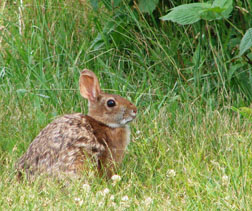 A central Massachusetts land owner sued for the right to build on his property without restriction, despite the fact that the land was deemed “priority habitat” for the state endangered Eastern box turtle. The case was first heard in court in 2009.
A central Massachusetts land owner sued for the right to build on his property without restriction, despite the fact that the land was deemed “priority habitat” for the state endangered Eastern box turtle. The case was first heard in court in 2009.
Last week the Massachusetts Supreme Judicial Court ruled against landowner, upholding the concept of priority habitat in the state. The landowner, however, did not argue that his land was not actually habitat for the turtle (although that is implied in the newspaper articles about the case), but that the Department of Fish and Game’s use of a “priority habitat” designation and rules was not found in the state’s endangered species law.
Because the legal case splits the difference between state law and agency regulations, the local newspaper’s coverage dives right in to all the hairsplitting details. There are many lessons here for state wildlife agencies regarding habitat designations for endangered species, although the big lesson seems to be if a rich guy wants to build his retirement home on endangered species habitat, expect a stink.
The tone of the articles favors the landowner, and it appears that many readers missed the point that the landowner has always been allowed to build on the land, but there are conditions he objects to. It also appears that the land was known box turtle habitat before the landowner purchased it.
The Springfield Republican article announcing last week’s verdict.
A past article by the Republican on the case.
Photo: Box turtle, courtesy US Fish and Wildlife Service

 Here’s some good news for a Monday morning.
Here’s some good news for a Monday morning. Bald eagle numbers are up in Georgia and Massachusetts, and a Wisconsin county has seen its first bald eagle nest in over 100 years.
Bald eagle numbers are up in Georgia and Massachusetts, and a Wisconsin county has seen its first bald eagle nest in over 100 years. Where did the turtle cross the road? A citizen scientist has the answer, particularly in Massachusetts, where over the last few years citizen scientists have been tracking turtle crossings as part of the Turtle Roadway Mortality Monitoring Program. Volunteers are trained by Linking Landscapes for Massachusetts Wildlife, a partnership between Division of Fisheries and Wildlife (DFW), Department of Transportation (DOT) Highway Division and the University of Massachusetts-Amherst.
Where did the turtle cross the road? A citizen scientist has the answer, particularly in Massachusetts, where over the last few years citizen scientists have been tracking turtle crossings as part of the Turtle Roadway Mortality Monitoring Program. Volunteers are trained by Linking Landscapes for Massachusetts Wildlife, a partnership between Division of Fisheries and Wildlife (DFW), Department of Transportation (DOT) Highway Division and the University of Massachusetts-Amherst. Last autumn, nine New England cottontails bred in captivity at the Roger Williams Park Zoo in Rhode Island were released inside a predator-proof fence enclosing one acre of the Ninigret National Wildlife Refuge, also in Rhode Island.
Last autumn, nine New England cottontails bred in captivity at the Roger Williams Park Zoo in Rhode Island were released inside a predator-proof fence enclosing one acre of the Ninigret National Wildlife Refuge, also in Rhode Island. Things have actually been pretty quiet over the past month when it comes to wildlife diseases. The big news, of course, is
Things have actually been pretty quiet over the past month when it comes to wildlife diseases. The big news, of course, is 



